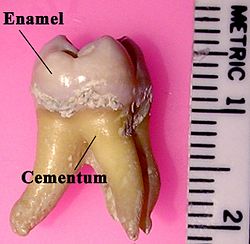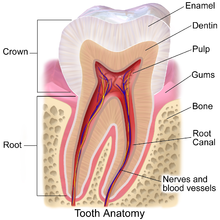Features and Structure of Tooth Enamel
- Enamel is the hardest substance in the human body, composed of 96% minerals.
- The primary mineral in enamel is hydroxyapatite, a crystalline calcium phosphate.
- Enamel is formed on the tooth during development and does not contain blood vessels or nerves.
- Remineralisation can repair some damage to enamel, but beyond a certain point, it cannot be repaired by the body.
- Enamel varies in thickness and color, with yellowish teeth having a thin, translucent enamel and grayish teeth having a more opaque enamel.
- Enamel is made up of tightly packed enamel rods, which are organised in a keyhole pattern.
- The arrangement of crystallites within each enamel rod is complex, with different orientations in the head and tail of the rod.
- Enamel rods are found in rows along the tooth, generally perpendicular to the underlying dentin.
- Interrod enamel surrounds the enamel rods and has a similar composition.
- Incremental lines called Striae of Retzius and Perikymata can be observed in mature enamel, indicating growth patterns.
Enamel Development and Composition
- Enamel formation is part of the overall process of tooth development.
- Enamel formation occurs after the establishment of dentin, through cells called ameloblasts.
- Enamel forms at a rate of around 4μm per day, starting at the future location of cusps.
- Enamel formation can be divided into the secretory stage and the maturation stage.
- The secretory stage involves the formation of a partially mineralised enamel, while the maturation stage completes enamel mineralization.
- Enamel is composed primarily of minerals, with water and organic material making up the rest.
- Enamel does not contain collagen like other hard tissues.
- Enamel contains unique classes of proteins called amelogenins and enamelins, which aid in enamel development.
- Once mature, enamel is almost entirely without organic matter.
- Enamel is avascular and does not have a nerve supply.
Strength and Properties of Enamel
- Enamel is the hardest substance in the human body, ranking 5 on Mohs hardness scale.
- Enamel is brittle due to its high mineral content.
- Dentin, less mineralised and less brittle than enamel, provides support.
- Enamel appears lighter than dentin or pulp on radiographs due to its higher density.
- Enamel undergoes mineralization changes but is not renewed.
Enamel Destruction and Factors Affecting Enamel Destruction
- Enamel cannot regenerate itself.
- Enamel can be affected by decay or injury.
- Enamel is covered by structures such as the Nasmyth membrane and acquired pellicle.
- Enamel demineralizes in a process known as dental caries or cavities.
- Tooth decay is caused by acids dissolving tooth enamel.
- Fermentable carbohydrates are the main cause of tooth decay.
- Bacteria in the mouth interact with sugars to form lactic acid, decreasing the pH.
- Critical pH for enamel demineralization is generally accepted to be pH 5.5.
- Tooth morphology makes deep grooves, pits, and fissures susceptible to decay.
- Bruxism, tooth wear, and enamel fractures also contribute to enamel destruction.
Prevention, Maintenance, and Dental Procedures Related to Enamel
- Oral hygiene is crucial for preventing tooth decay and maintaining enamel health.
- Toothbrushes reduce dental biofilm and food particles on enamel.
- In isolated societies without toothbrushes, alternative objects like sticks are used for teeth cleaning.
- Regular dental check-ups and professional cleanings help maintain enamel health.
- Proper diet and limiting sugar intake can also prevent enamel destruction.
- Fluoride catalyzes diffusion of calcium and phosphate into tooth surface, aiding in remineralization.
- Dental restorations involve removal of enamel.
- Dental sealants prevent decay by 55% over 7 years.
- Acid-etching techniques are used to bond restorations to teeth.
- Tooth whitening attempts to lighten tooth color chemically or mechanically.
Tooth enamel is one of the four major tissues that make up the tooth in humans and many animals, including some species of fish. It makes up the normally visible part of the tooth, covering the crown. The other major tissues are dentin, cementum, and dental pulp. It is a very hard, white to off-white, highly mineralised substance that acts as a barrier to protect the tooth but can become susceptible to degradation, especially by acids from food and drink. In rare circumstances enamel fails to form, leaving the underlying dentin exposed on the surface.
| Tooth enamel | |
|---|---|
 Labeled molar | |
| Details | |
| Identifiers | |
| Latin | enamelum |
| MeSH | D003743 |
| TA98 | A05.1.03.056 |
| TA2 | 938 |
| FMA | 55629 |
| Anatomical terminology | |

tooth enamel (uncountable)